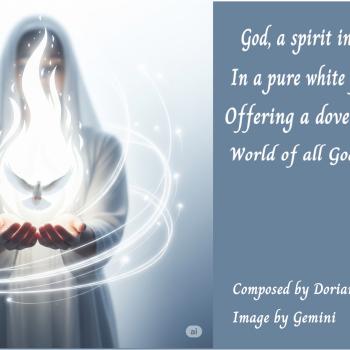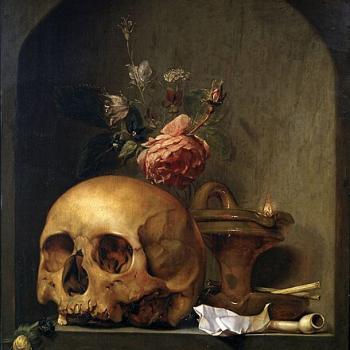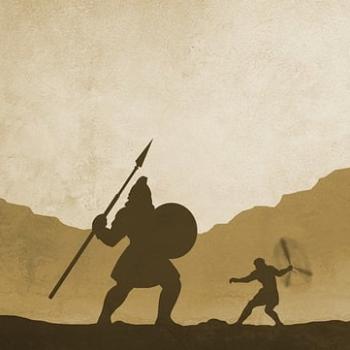When you make the two into one, and when you make that which is outside [you] like that which is inside [you] and when you make that which is above like that which is below (macrocosm and microcosm) and when you make the male and the female into a single one [being]... then you will be able to enter the Kingdom.
The nature of things might be quite different in a parallel universe, but in our universe virtually everything manifests itself in pairs of opposites: night and day, good and evil, hate and love, wealth and poverty, darkness and light, health and sickness, male and female. Even the human brain is composed of two hemispheres—one analytical, the other intuitive: masculine and feminine.
Pairs of opposites have male/female characteristics. Yin is feminine; Yang is masculine. Tao is the intermixing of both, and the Tao would not exist without both. Hindus use Shiva and Shakti to express the same idea, yet understand that Shiva and Shakti are dualistic aspects of the one monistic Brahman. Buddhists call this spiritual sexual pairing Yab/Yum. In Hebrew, knowledge is masculine, while wisdom is feminine.
In orthodox Christianity—though few Christians realize it—the Holy Spirit always appears in the original Greek of the New Testament as feminine. The metaphorical goddess, Sofia, or wisdom, is also feminine. In the Jewish Kabbalah, the female principle is known as the Shekinah. The human need for the feminine principle is so strong that even in patriarchal traditions like Roman Catholicism, the patriarchs were forced to re-invent Jesus' mother as an immaculate virgin (now the Queen of Heaven) in order to restore the lost feminine aspect to orthodoxy.
Gods and goddesses (consorts) are everywhere in religious mythology.
Even though we live in the apparent world of duality, there is a strong human need to heal separateness. Contrary to what many women believe today, in ancient texts, the goddess almost never exists alone; she is nearly always the consort of the male principle—which is to say that neither the god nor the goddess can exist without the other.
Coupling metaphors run through all mystical traditions. The third century Gnostic The Gospel of Philip hints that the historical Mary Magdalene was considered a personification of Sophia, or Wisdom and was, therefore, a goddess and cosmic consort of the Christ. In Tibetan Buddhism, the historical Yeshe Tsogyel is considered to be the consort of Padmasambahva, the founder of Buddhism in Tibet.
At some deep primordial level we seem to understand this need for wholeness. We need the balance between the pairs of opposites. Nondualism—androgyny—is the only thing that can overcome patriarchal bias and restore our gender balance that is so essential. In the material realm, however, the One always includes the Two.
Why is our universe manifested in this way? I think we can safely say that we'll never be able to answer the why question. But obviously we do not see ourselves as existing in the realm of pure Spirit. We believe that we do exist, however; and by all appearances, we do. And that is a paradox: in order to realize Ultimate Reality, we must (consciously) cease seeing ourselves as separate and apart—but without mystic insight, this is impossible.
Buddhists and Hindus believe that the phenomenal world is illusory, but many of them still live in houses, drive cars, go to work, and make love. The simple intellectual realization that only the One exists is obviously not sufficient for Enlightenment; nor is the mere belief that phenomenal reality is essentially an illusion. The only way we can become whole and illumined is to altogether disengage the thinking mind and overcome the misapprehension that we are individual, separate beings—separate from each other and separate from the One-Who-Is.
Like Taoists, the ancient Buddhist philosopher Nagarjuna taught that "reality" exists in polarity. Everything exists in relationship to its opposite, and the opposites are continuously reversing poles. Modern science agrees: "Every action has an equal and opposite reaction."
Nagarjuna pointed out that shortness exists only in relation to the idea of length. "When bigness is present, smallness comes into being. When smallness is present, bigness comes to be. When evil arises, goodness comes to be; and when goodness arises, evil comes into being." This is a radical idea for most people, but it is the law of the universe: Goodness, in effect, forces evil into existence and vice versa. Every action has an equal, and opposite, reaction. Nagarjuna and Taoists both taught that these polarities are fixed and immutable.
According to the second law of thermodynamics, the universe—the cosmos as a whole—is a closed system, which means the laws within it never vary, and there is nothing outside a closed system that can affect those laws. In a closed system, disorder can never decrease, and order can never increase. According to quantum theory, the information that creates or maintains order must be constant. It cannot increase or decrease, which means chaos cannot exist without an equal amount of order, and order cannot exist without an equal amount of chaos.




